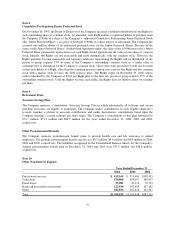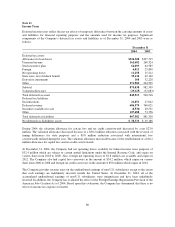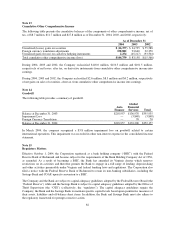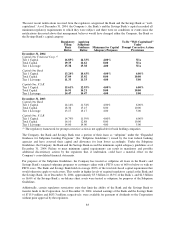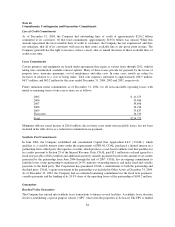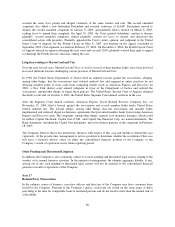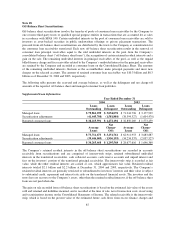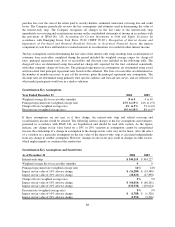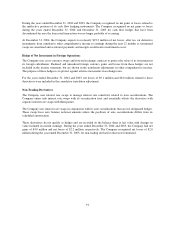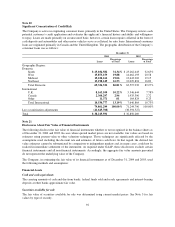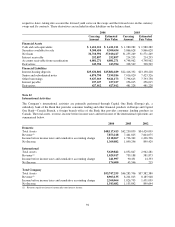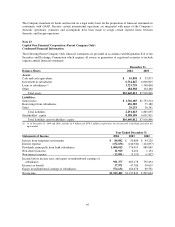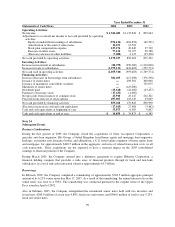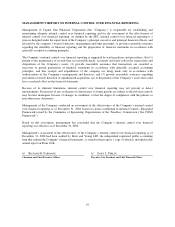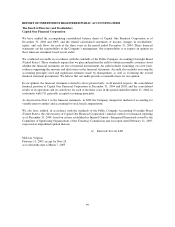Capital One 2004 Annual Report Download - page 112
Download and view the complete annual report
Please find page 112 of the 2004 Capital One annual report below. You can navigate through the pages in the report by either clicking on the pages listed below, or by using the keyword search tool below to find specific information within the annual report.
Static pool credit losses are calculated by summing the actual and projected future credit losses and dividing
them by the original balance of each pool of assets. Due to the short-term revolving nature of the consumer loan
receivables, the weighted average percentage of static pool credit losses is not considered materially different
from the assumed charge-off rates used to determine the fair value of the retained interests.
The Company acts as a servicing agent and receives contractual servicing fees of between 0.50% and 6% of the
investor principal outstanding, based upon the type of assets serviced. The Company generally does not record
material servicing assets or liabilities for these rights since the contractual servicing fee approximates market
rates.
Securitization Cash Flows
Year Ended December 31 2004 2003
Proceeds from new securitizations $10,854,927 $11,466,122
Collections reinvested in revolving-period securitizations 63,050,917 59,574,458
Repurchases of accounts from the trust ——
Servicing fees received 766,883 693,166
Cash flows received on retained interests(1) 3,668,344 2,901,126
(1) Includes all cash receipts of excess spread and other payments (excluding servicing fees) from the Trust to the Company.
For the year ended December 31, 2004, the Company recognized gross gains of $55.8 million on the sale of
$10.9 billion of consumer loan principal receivables compared to gross gains of $62.0 million on the sale of
$11.5 billion of consumer loan principal receivables for the year ended December 31, 2003 and gross gains of
$73.6 million on the sale of $12.5 billion of consumer loans in 2002. These gross gains are included in servicing
and securitization income. In addition, the Company recognized, as a reduction to servicing and securitization
income, upfront securitization transaction costs and recurring credit facility commitment fees of $69.0 million,
$88.6 million and $43.5 million for the years ended December 31, 2004, 2003 and 2002, respectively. The
remainder of servicing and securitizations income represents servicing income and excess interest and non-
interest income generated by the transferred receivables, less the related net losses on the transferred receivables
and interest expense related to the securitization debt.
Note 19
Derivative Instruments and Hedging Activities
The Company maintains a risk management strategy that incorporates the use of derivative instruments to
minimize significant unplanned fluctuations in earnings caused by interest rate and foreign exchange rate
volatility. The Company’s goal is to manage sensitivity to changes in rates by modifying the repricing or
maturity characteristics of certain balance sheet assets and liabilities, thereby limiting the impact on earnings. By
using derivative instruments, the Company is exposed to credit and market risk. If the counterparty fails to
perform, credit risk is equal to the extent of the fair value gain in a derivative. When the fair value of a derivative
contract is positive, this generally indicates that the counterparty owes the Company, and, therefore, creates a
repayment risk for the Company. When the fair value of a derivative contract is negative, the Company owes the
counterparty, and therefore, has no repayment risk. The Company minimizes the credit (or repayment) risk in
derivative instruments by entering into transactions with high-quality counterparties that are reviewed
periodically by the Company’s Asset and Liability Committee, a committee of Senior Management. The
Company also maintains a policy of requiring that all derivative contracts be governed by an International Swaps
and Derivatives Association Master Agreement; depending on the nature of the derivative transaction, bilateral
collateral agreements may be required as well.
Market risk is the adverse effect that a change in interest rates, currency, or implied volatility rates has on the
value of a financial instrument. The Company manages the market risk associated with interest rate and foreign
exchange contracts by establishing and monitoring limits as to the types and degree of risk that may be
undertaken.
89


